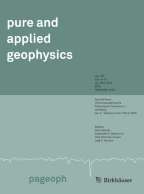1423Accesses
186Citations
211 Altmetric
27Mentions
Abstract
On July 10, 1958, an earthquake Mw 8.3 along the Fairweather fault triggered a major subaerial landslide into Gilbert Inlet at the head of Lituya Bay on the southern coast of Alaska. The landslide impacted the water at high speed generating a giant tsunami and the highest wave runup in recorded history. The mega-tsunami runup to an elevation of 524 m caused total forest destruction and erosion down to bedrock on a spur ridge in direct prolongation of the slide axis. A cross section of Gilbert Inlet was rebuilt at 1:675 scale in a two-dimensional physical laboratory model based on the generalized Froude similarity. A pneumatic landslide tsunami generator was used to generate a high-speed granular slide with controlled impact characteristics. State-of-the-art laser measurement techniques such as particle image velocimetry (PIV) and laser distance sensors (LDS) were applied to the decisive initial phase with landslide impact and wave generation as well as the runup on the headland. PIV provided instantaneous velocity vector fields in a large area of interest and gave insight into kinematics of wave generation and runup. The entire process of a high-speed granular landslide impact may be subdivided into two main stages: (a) Landslide impact and penetration with flow separation, cavity formation and wave generation, and (b) air cavity collapse with landslide run-out and debris detrainment causing massive phase mixing. Formation of a large air cavity — similar to an asteroid impact — in the back of the landslide is highlighted. A three-dimenional pneumatic landslide tsunami generator was designed, constructed and successfully deployed in the tsunami wave basin at OSU. The Lituya Bay landslide was reproduced in a three-dimensional physical model at 1:400 scale. The landslide surface velocities distribution was measured with PIV. The measured tsunami amplitude and runup heights serve as benchmark for analytical and numerical models.
This is a preview of subscription content,log in via an institution to check access.
Access this article
Subscribe and save
- Starting from 10 chapters or articles per month
- Access and download chapters and articles from more than 300k books and 2,500 journals
- Cancel anytime
Buy Now
Price includes VAT (Japan)
Instant access to the full article PDF.
Similar content being viewed by others
Explore related subjects
Discover the latest articles, books and news in related subjects, suggested using machine learning.Author information
Authors and Affiliations
School of Civil and Environmental Engineering, Georgia Institute of Technology, 210 Technology Circle, Savannah, GA, 31407, U.S.A.
Hermann M. Fritz, Fahad Mohammed & Jeseon Yoo
- Hermann M. Fritz
Search author on:PubMed Google Scholar
- Fahad Mohammed
Search author on:PubMed Google Scholar
- Jeseon Yoo
Search author on:PubMed Google Scholar
Corresponding author
Correspondence toHermann M. Fritz.
Rights and permissions
About this article
Cite this article
Fritz, H.M., Mohammed, F. & Yoo, J. Lituya Bay Landslide Impact Generated Mega-Tsunami 50th Anniversary.Pure appl. geophys.166, 153–175 (2009). https://doi.org/10.1007/s00024-008-0435-4
Received:
Revised:
Published:
Issue date:
Share this article
Anyone you share the following link with will be able to read this content:
Sorry, a shareable link is not currently available for this article.
Provided by the Springer Nature SharedIt content-sharing initiative



